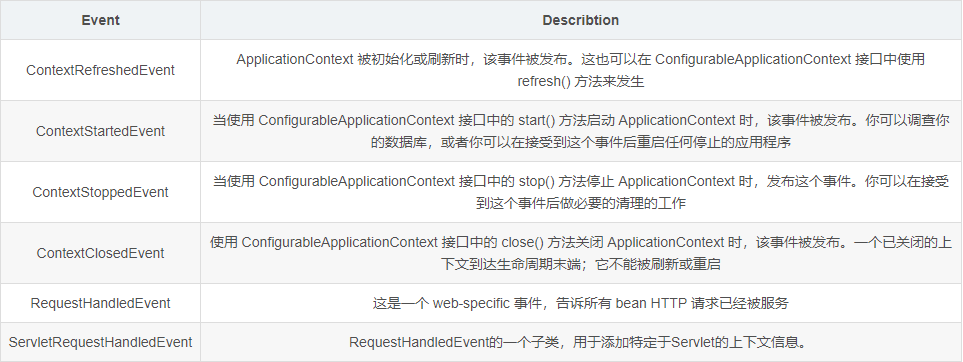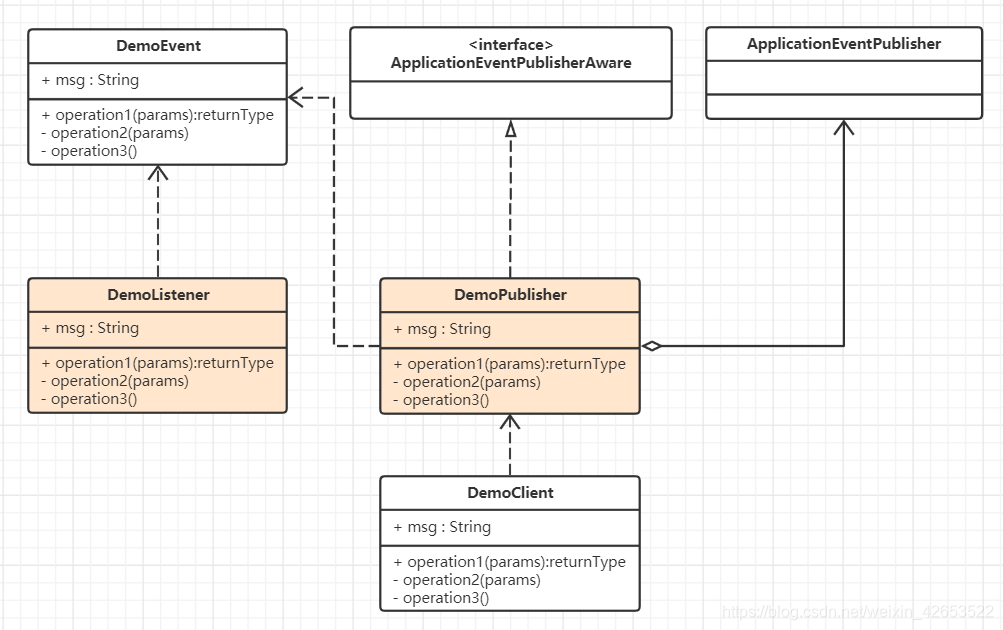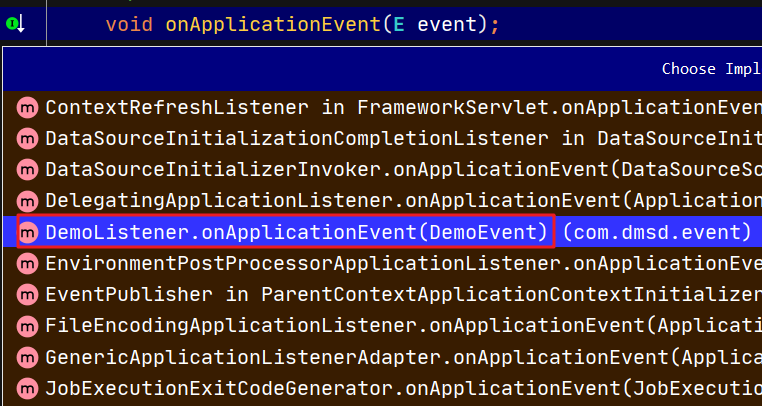-
前言
-
ApplicationEvent 与 ApplicationListener 应用
-
实现
-
基于注解
-
事件过滤
-
异步事件监听
-
-
好处及应用场景
-
源码阅读
-
总结
1前言
ApplicationContext 中的事件处理是通过 ApplicationEvent 类和 ApplicationListener 接口提供的。如果将实现了 ApplicationListener 接口的 bean 部署到容器中,则每次将 ApplicationEvent 发布到ApplicationContext 时,都会通知到该 bean,这简直是典型的观察者模式。设计的初衷就是为了系统业务逻辑之间的解耦,提高可扩展性以及可维护性。
Spring 中提供了以下的事件

2ApplicationEvent 与 ApplicationListener 应用
实现
1、自定义事件类,基于 ApplicationEvent 实现扩展
public class DemoEvent extends ApplicationEvent {private static final long serialVersionUID = -2753705718295396328L;private String msg;public DemoEvent(Object source, String msg) {super(source);this.msg = msg;}public String getMsg() {return msg;}public void setMsg(String msg) {this.msg = msg;}
}
2、定义 Listener 类,实现 ApplicationListener接口,并且注入到 IOC 中。等发布者发布事件时,都会通知到这个bean,从而达到监听的效果。
@Component
public class DemoListener implements ApplicationListener<DemoEvent> {@Overridepublic void onApplicationEvent(DemoEvent demoEvent) {String msg = demoEvent.getMsg();System.out.println("bean-listener 收到了 publisher 发布的消息: " + msg);}
}
3、要发布上述自定义的 event,需要调用 ApplicationEventPublisher 的 publishEvent 方法,我们可以定义一个实现 ApplicationEventPublisherAware 的类,并注入 IOC来进行调用。
@Component
public class DemoPublisher implements ApplicationEventPublisherAware {private ApplicationEventPublisher applicationEventPublisher;@Overridepublic void setApplicationEventPublisher(ApplicationEventPublisher applicationEventPublisher) {this.applicationEventPublisher = applicationEventPublisher;}public void sendMsg(String msg) {applicationEventPublisher.publishEvent(new DemoEvent(this, msg));}
}
4、客户端调用 publisher
@RestController
@RequestMapping("/event")
public class DemoClient implements ApplicationContextAware {private ApplicationContext applicationContext;@Overridepublic void setApplicationContext(ApplicationContext applicationContext) throws BeansException {this.applicationContext = applicationContext;}@GetMapping("/publish")public void publish(){DemoPublisher bean = applicationContext.getBean(DemoPublisher.class);bean.sendMsg("发布者发送消息......");}
}
输出结果:
bean-listener 收到了 publisher 发布的消息: 发布者发送消息......
基于注解
我们可以不用实现 AppplicationListener 接口 ,在方法上使用 @EventListener 注册事件。如果你的方法应该侦听多个事件,并不使用任何参数来定义,可以在 @EventListener 注解上指定多个事件。
重写 DemoListener 类如下:
public class DemoListener {@EventListener(value = {DemoEvent.class, TestEvent.class})public void processApplicationEvent(DemoEvent event) {String msg = event.getMsg();System.out.println("bean-listener 收到了 publisher 发布的消息: " + msg);}
}
事件过滤
如果希望通过一定的条件对事件进行过滤,可以使用 @EventListener 的 condition 属性。以下实例中只有 event 的 msg 属性是 my-event 时才会进行调用。
@EventListener(value = {DemoEvent.class, TestEvent.class}, condition = "#event.msg == 'my-event'")
public void processApplicationEvent(DemoEvent event) {String msg = event.getMsg();System.out.println("bean-listener 收到了 publisher 发布的消息: " + msg);}
此时,发送符合条件的消息,listener 才会侦听到 publisher 发布的消息。
bean-listener 收到了 publisher 发布的消息: my-event
异步事件监听
前面提到的都是同步处理事件,那如果我们希望某个特定的侦听器异步去处理事件,如何做?
使用 @Async 注解可以实现类内方法的异步调用,这样方法在执行的时候,将会在独立的线程中被执行,调用者无需等待它的完成,即可继续其他的操作。
@EventListener
@Async
public void processApplicationEvent(DemoEvent event) {String msg = event.getMsg();System.out.println("bean-listener 收到了 publisher 发布的消息: " + msg);
}
使用异步监听时,有两点需要注意:
-
如果异步事件抛出异常,则不会将其传播到调用方。
-
异步事件监听方法无法通过返回值来发布后续事件,如果需要作为处理结果发布另一个事件,请插入
ApplicationEventPublisher以手动发布事件
3好处及应用场景
ApplicationContext 在运行期会自动检测到所有实现了 ApplicationListener 的 bean,并将其作为事件接收对象。当我们与 spring 上下文交互触发 publishEvent 方法时,每个实现了 ApplicationListener 的 bean 都会收到 ApplicationEvent 对象,每个 ApplicationListener 可以根据需要只接收自己感兴趣的事件。
这样做有什么好处呢?
在传统的项目中,各个业务逻辑之间耦合性比较强,controller 和 service 间都是关联关系,然而,使用 ApplicationEvent 监听 publisher 这种方式,类间关系是什么样的?我们不如画张图来看看。
DemoPublisher 和 DemoListener 两个类间并没有直接关联,解除了传统业务逻辑两个类间的关联关系,将耦合降到最小。这样在后期更新、维护时难度大大降低了。

ApplicationEvent 使用观察者模式实现,那什么时候适合使用观察者模式呢?观察者模式也叫 发布-订阅模式,例如,微博的订阅,我们订阅了某些微博账号,当这些账号发布消息时,我们都会收到通知。
总结来说,定义对象间的一种一对多的依赖关系,当一个对象的状态发生改变时,所有依赖于它的对象都得到通知并被自动更新,从而实现广播的效果。
4源码阅读

Spring中的事件机制流程
1、ApplicationEventPublisher是Spring的事件发布接口,事件源通过该接口的pulishEvent方法发布事件
2、ApplicationEventMulticaster就是Spring事件机制中的事件广播器,它默认提供一个SimpleApplicationEventMulticaster实现,如果用户没有自定义广播器,则使用默认的。它通过父类AbstractApplicationEventMulticaster的getApplicationListeners方法从事件注册表(事件-监听器关系保存)中获取事件监听器,并且通过invokeListener方法执行监听器的具体逻辑
3、ApplicationListener就是Spring的事件监听器接口,所有的监听器都实现该接口,本图中列出了典型的几个子类。其中RestartApplicationListnener在SpringBoot的启动框架中就有使用
4、在Spring中通常是ApplicationContext本身担任监听器注册表的角色,在其子类AbstractApplicationContext中就聚合了事件广播器ApplicationEventMulticaster和事件监听器ApplicationListnener,并且提供注册监听器的addApplicationListnener方法
ChatGPT中文网站:https://ai.cxyquan.com/
通过上图就能较清晰的知道当一个事件源产生事件时,它通过事件发布器ApplicationEventPublisher发布事件,然后事件广播器ApplicationEventMulticaster会去事件注册表ApplicationContext中找到事件监听器ApplicationListnener,并且逐个执行监听器的onApplicationEvent方法,从而完成事件监听器的逻辑。
来到ApplicationEventPublisher 的 publishEvent 方法内部
protected void publishEvent(Object event, @Nullable ResolvableType eventType) {if (this.earlyApplicationEvents != null) {this.earlyApplicationEvents.add(applicationEvent);}else {// getApplicationEventMulticaster().multicastEvent(applicationEvent, eventType);}
}
多播事件方法
@Override
public void multicastEvent(final ApplicationEvent event, @Nullable ResolvableType eventType) {ResolvableType type = (eventType != null ? eventType : resolveDefaultEventType(event));Executor executor = getTaskExecutor();// 遍历所有的监听者for (ApplicationListener<?> listener : getApplicationListeners(event, type)) {if (executor != null) {// 异步调用监听器executor.execute(() -> invokeListener(listener, event));}else {// 同步调用监听器invokeListener(listener, event);}}
}
invokeListener
protected void invokeListener(ApplicationListener<?> listener, ApplicationEvent event) {ErrorHandler errorHandler = getErrorHandler();if (errorHandler != null) {try {doInvokeListener(listener, event);}catch (Throwable err) {errorHandler.handleError(err);}}else {doInvokeListener(listener, event);}
}
doInvokeListener
private void doInvokeListener(ApplicationListener listener, ApplicationEvent event) {try {// 这里是事件发生的地方listener.onApplicationEvent(event);}catch (ClassCastException ex) {......}
}
点击 ApplicationListener 接口 onApplicationEvent 方法的实现,可以看到我们重写的方法。

5总结
Spring 使用反射机制,获取了所有继承 ApplicationListener 接口的监听器,在 Spring 初始化时,会把监听器都自动注册到注册表中。
Spring 的事件发布非常简单,我们来总结一下:
-
定义一个继承
ApplicationEvent的事件 -
定义一个实现
ApplicationListener的监听器或者使用@EventListener监听事件 -
定义一个发送者,调用
ApplicationContext直接发布或者使用ApplicationEventPublisher来发布自定义事件
最后,发布-订阅模式可以很好的将业务逻辑进行解耦(上图验证过),大大提高了可维护性、可扩展性。






)
的问题排查)











